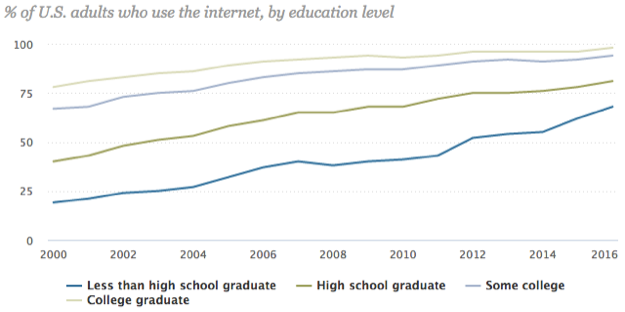More people in the U.S. have broadband service at home than ever before, according to the latest numbers released by the Pew Foundation. After a couple of years where residential adoption dipped, it’s on the way back up, albeit unevenly…
Between 2013 and 2015, the share of Americans with home broadband service decreased slightly – from 70% to 67%. But in the past year, broadband adoption rates have returned to an upward trajectory. As of November 2016, nearly three-quarters (73%) of Americans indicate that they have broadband service at home. But although broadband adoption has increased to its highest level since the Center began tracking this topic in early 2000, not all Americans have shared in these gains. For instance, those who have not graduated from high school are nearly three times less likely than college graduates to have home broadband service (34% vs. 91%). Broadband adoption also varies by factors such as age, household income, geographic location and racial and ethnic background.
Overall, a record 88% of U.S. adults make use of the Internet, either at home or elsewhere. Again, that use is not evenly distributed throughout the population. Pretty much all adults younger than 30 years old – 99% – are connected, but less than two-thirds as many – 64% – of people 65 and older go online.
Income and education matter – there’s a clear drop from the 98% usage level among the highest earning and best educated adults to the 79% adoption rate among those in the lowest income category and 68% among the least educated. Where people live matters, too – urban and suburban residents are right around 90% mark, but rural Internet use is significantly lower at 81%.
On the other hand, race and gender don’t seem to be a factor according to the Pew study, at least from a top level analysis perspective. Men and women, and whites, blacks and latinos are within 3% of each other – all in the mid to high 80% range.

